2017 下半年辽宁教师资格考试初中英语学科知识与教学能
力真题及答案
注意事项:
1.考试时间 120 分钟,满分 150 分。
2.请按规定在答题卡上填涂、作答。在试卷上作答无效,不予评分。
一、单项选择题(本大题共 30 小题,每小题 2 分,共 60 分)
在每小题列出的四个备选项中选择一个最佳答案。请用 28 铅笔把答题卡上对应题目的答
案字母按要求涂黑。错选、多选或未选均无分。
1. The main difference between/e/and/ə/lies in the__________.
A. tongue position
B. sound duration
C. openness of the mouth
D. shape of the lips
2.__________is the main rhyming pattern in"Mrs. White/Had a flight/In the
middle of the night".
A. Assonance
B. End rhyme
C. Alliteration
D. Reverse end rhyme
3. We're all keeping our__________ crossed that the surgeons do not find
anything too serious with the patient.
A. fingers
B. thumbs
C. hands
D. feet
4. When implementing the project, we__________a lot of unexpected opposition
from our colleagues.
�
A. run for
B. make against
C. run up against
D. make away with
5. The island measures about 30 miles__________ 20 miles.
A. by
B. with
C. to
D. upon
6. --Will John come to the party?
--No, he won't come and__________.
A. Antony neither won' t
B. won' t Antony neither
C. either will Antony
D. neither will Antony
7. Garbo plays the role of the queen,_________ in the love she has found with
Antonio.
A. rejoiced
B. rejoicing
C. being rejoiced
D. to rejoice
8._________ ministers decide to instigate an inquiry, we welcome it.
A. Should ... would
B. Suppose ... could
C, If... would
D. Would ... will
�
9. What is missing at the discourse level between the two sentences "Carol
loves tomatoes. She was born in Africa."?
A. Reference.
B. Cohesion.
C. Coherence.
D. Substitution.
10. The synonyms "charge" and "accuse" mainly differ in_________.
A. emotion
B. dialect
C. formality
D. collocation
11. Which of the following instructions is helpful in developing students'
ability to make inferences?
A. Listen to a story and write a summary.
B. Listen to a story and work out the writer' s intention.
C. Listen to the story of a boy and then draw a picture of him.
D. Listen to a story and note down the specific date of an event.
12. The most suitable question type to check students' comprehension and
develop their critical thinking is_________.
A. rhetorical questions
B. referential questions
C. close questions
D. display questions
13. Diagnostic test is often used for the purpose of
A. finding out what students know and don' t know
B. measuring students' general language proficiency
C. knowing whether students have the right language aptitude
�
D. checking whether students have achieved the teaching objectives
14. Which of the following activities is often used to develop students'
speaking accuracy?
A. Identifying and correcting oral mistakes.
B. Acting out the dialogue in the text.
C. Having discussions in groups.
D. Describing people in pair.
15. If a teacher asks students to make their own learning plan, he/she is
trying to develop their_________.
A. cognitive strategy
B. affective strategy
C. communicative strategy
D. metacognitive strategy
16. When a teacher tells students that the word "dog" may imply "loyalty",
he/she is teaching the _________of the word.
A, denotative meaning
B. conocative meaning
C. conceptual meaning
D. connotative meaning
17. Which of the following is the last step in the process of writing essays?
A. Editing the writings.
B. Writing topic sentences for paragraphs.
C. Gathering information and ideas relevant to the topic.
D. Organizing the information and ideas into a logical sequence.
18. The main purpose of asking questions about the topic before listening is
to
A. meet students' expectation
�
B. increase students' confidence
C. activate students' schemata
D. provide feedback on tasks
19. Ifa teacher asks students to fill in the blanks in a passage with "that",
"which" or "whom",he/she is least likely focusing on grammar at_________.
A. lexical level
B. syntactic level
C. discourse level
D. morphological level
20. If a teacher asks students to talk about their hobbies in groups, he/she
is trying to encourage_________.
A. peer correction
B. peer feedback
C. peer interaction
D. peer assessment
请阅读 Passage l,完成第 21-25 小题。
Passage 1
Self-driving vehicles threaten to send truck drivers to the unemployment
office. Computer programs can now write journalistic accounts of sporting
events and stock price movements. There are even computers that can grade
essay exams with reasonable accuracy, which could revolutionize my own job.
Increasingly, machines are providing not only the brawn but the brains, too.
And that raises the question of where humans fit into this picture--who will
prosper and who won't in this new kind of machine economy?
Within five years we are likely to have the world's best education, or close
to it, online and free. But not everyone will sit down and go through the
material without a professor pushing them to do the work.
Your Smartphone will record data on your life and, when asked, will tell you
what to do,drawing on data from your home or from your spouse and friends if
need be."You' ve thrown out that bread the last three times you've bought it,
give it a pass" will be a text message of the future.
�
How about"Now is not the time to start another argument with your wife"? The
GPS is just the beginning of computer-guided instruction. Take your Smartphone
on a date, and it might vibrate in your pocket to indicate "Kiss her now." If
you hesitate for fear of being seen as pushy, it may write:
"Who cares if you look bad? You are sampling optimally in the quest for a
lifetime companion."
A lot of jobs will consist of making people feel either very good or very bad
about themselves.
Coaches, mentors and disciplinarians will spread to many areas of life, at
least for those of us who can stand to listen to them. These people will
cajole us, flatter us and shame us into improving our lives, our work habits
and our consumption.
Computing and software will make it easier to measure performance and
productivity.
It will be harder to gloss over our failings and maintain self-deception. In
essence everyone will suffer the fate of professional chess players, who will
always know when they have lost a game, have an exact numerical rating for
their overall performance, and find excuses for failure hard to come by.
Individuals will have many measures of their proficiency. They will have an
incentive to disclose that information to get the better job or social
opportunity. You'll assume the worst about those who keep secrets, and so
openness will reign. Many of us will start to hate the idea of Big Data.
21. Which of the following is closest in meaning to the underlined word"brawn"
in Paragraph 1?
A. Job.
B. Meat.
C. Physical strength.
D. Mental agility.
22. What does the underlined phrase "the question" in Paragraph 1 refer to?
A. Where do humans fit into this picture?
B. Will machines eventually replace human beings?
C. Which could revolutionize my own job, teaching at school?
D. Who will prosper and who will not in this machine economy?
�
23. What makes the instructions sent by smartphones valuable and reliable for
people when doing things?
A. A global positioning system installed in all smartphones.
B. Information collected and elicited by smartphones from your life.
C. An optimal sampling software to store information in smartphones.
D. Vibrations smartphones make in your pocket as a constant reminder.
24. Who will be most likely to suffer from this technological revolution?
A. Fashion gurus specializing in producing, modeling, or marketing fashion.
B. American young people who do not make good use of the online courses.
C. Individuals keeping the information about their proficiency to themselves.
D. Professional chess players who are not able to calculate the play outcome.
25. Why will many people start to hate Big Data according to the last
paragraph?
A. Because people will have no privacy and can' t tell any lies at all.
B. Because they facilitate performance and productivity assessment.
C. Because they give people no choice but to comply with computers.
D. Because people have found it really hard to finish doing everything.
请阅读 Passage 2,完成第 26—30 小题。
Passage 2
education
provided
by
U.S.
colleges
been
Teacher
routinely criticized since its inception in the early nineteenth century,
sometimes deservedly. These programs, like non-university programs, are uneven
in quality and can be improved. What makes today' s criticisms different is an
groups,
aggressive
educational
entrepreneursto
expand
to
preparation
independent, alternative routes into teaching.
self-proclaimed
and
advocacy
the
deregulate
and
universities
teachers,
effort
has
by
and
of
This effort to"disrupt" the field of teacher preparation in the United States
has gained considerable momentum and legitimacy, with venture capitalists,
philanthropy, and the U.S.
Department of Education all providing sponsorship and substantial funding.
�
The strength of this effort is that the United States may quickly seek to
dismantle its university system and replace much of it with independent,
private programs. The resulting system of teacher preparation may differ
dramatically in its government, structure, content, and processes moving away
from its current location alongside legal, medical, and other professional
preparation that pairs academic degrees with professional training.
Throughout the nation, states are reporting teacher shortages in particular
subject areas and geographical locations, and several states have either
passed legislation to lower the standards for becoming a teacher or, like the
state of Washington, have looked toward expanding the number of teacher
education providers to try to fill teaching vacancies. The federal government
has contributed to the push to lower standards for becoming a teacher with the
Teacher Preparation Academy
provision in the new K-12 education law, the Every Student Succeeds Act, which
encourages states to expand the number of independent programs not associated
with colleges and universities.
Because of the increasing tuition rates, a consequence in part, of cuts in
funding to public universities that continue to educate most U.S. teachers,
enrollments in college and university teacher education programs have declined
in many parts of the country. Independent teacher education programs are being
viewed by some as an important part of the solution in staffing the nation's
classrooms and addressing our serious and enduring problems in education
inequities.
advocacy
Additionally,
education
entrepreneurs are working aggressively to expand these independent alternative
routes into teaching.
philanthropists,
so-called
groups,
and
Given the seriousness of the teacher shortage problem in the United States and
the substantial media attention that has been given to independent teacher
education
education
inequities, policy makers should very carefully examine the evidence that
exists about the nature and impact of these relatively new programs that are
rapidly expanding while university teacher education enrollments decline.
shortages
solution
programs
teacher
and
as
the
to
26. What can be inferred from Paragraph 1 about criticisms against teacher
education?
A. The criticisms have been increasing.
B. The criticisms may not be well justified sometimes.
C. The criticisms mainly focus on the quality of non-university programs.
D. The criticisms usually come from advocacy groups and so-called educational
entrepreneurs.
�
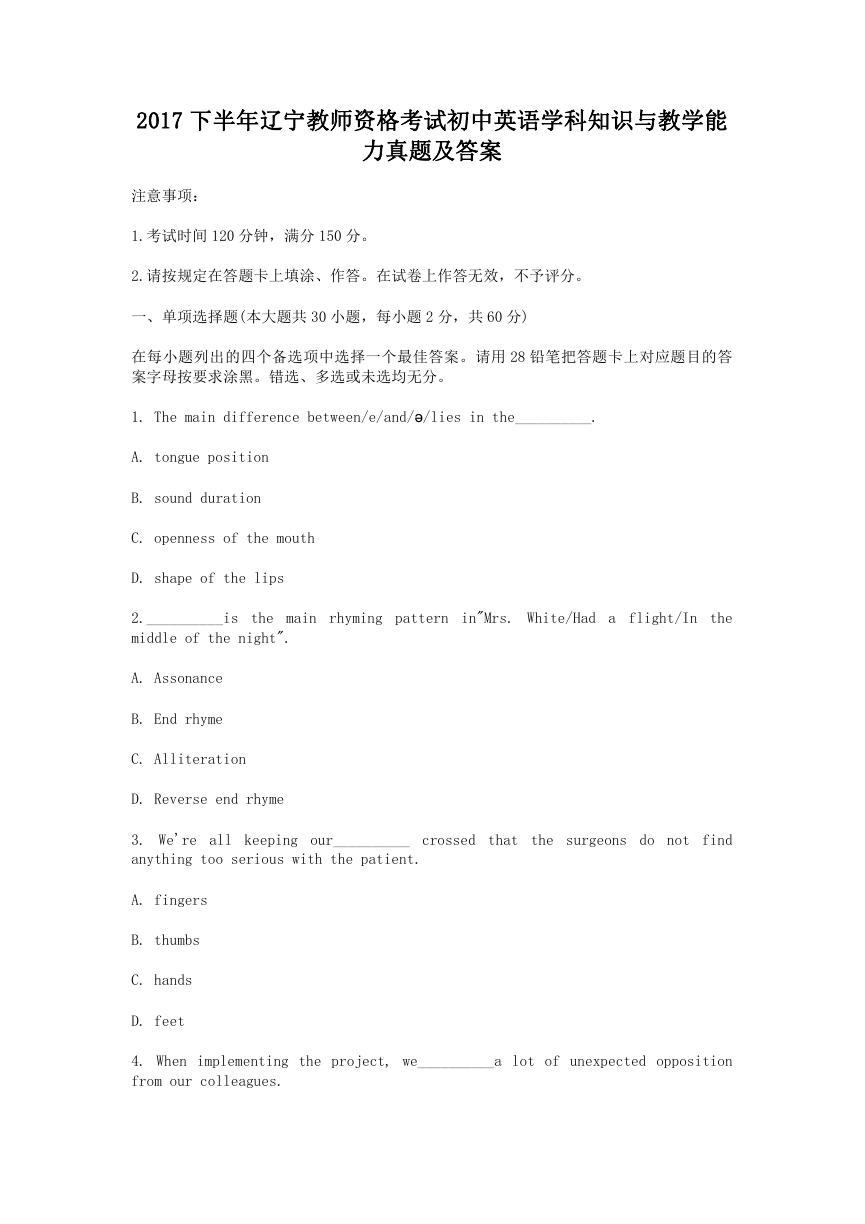
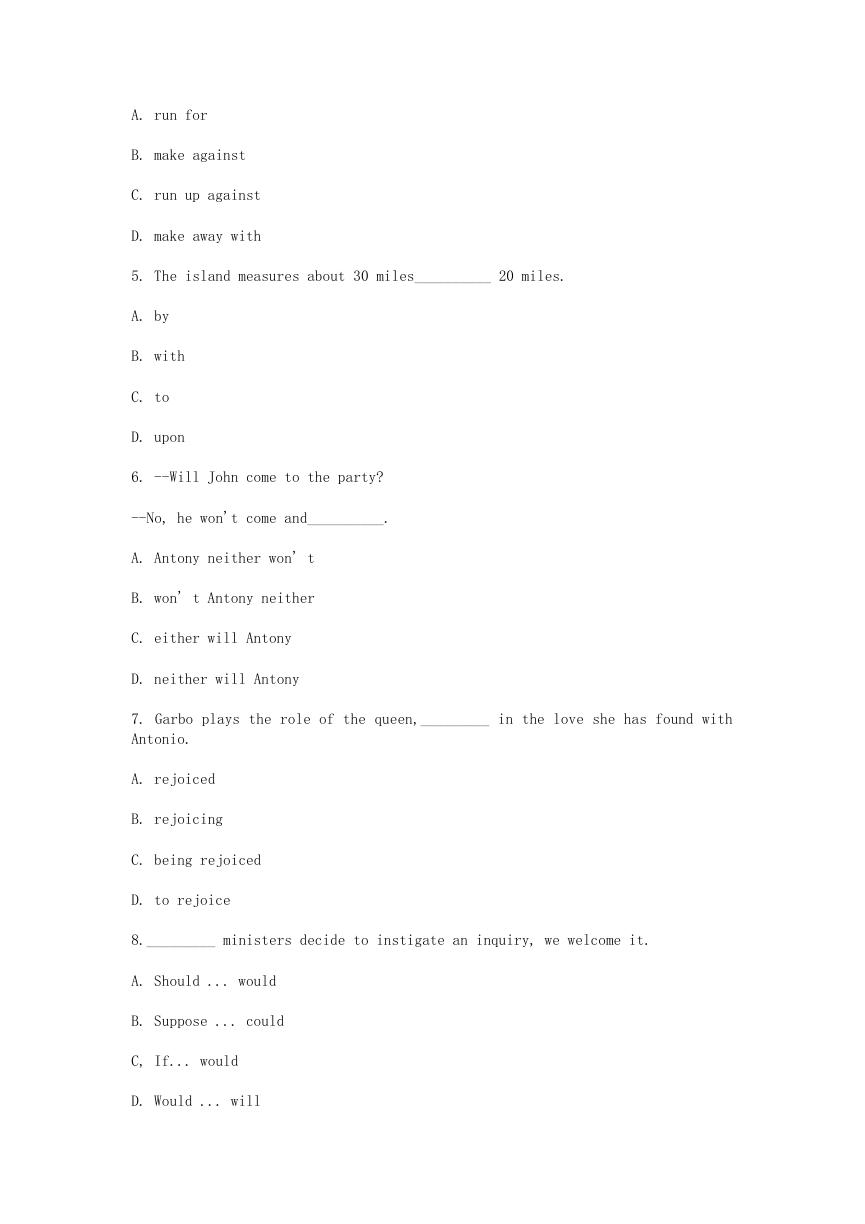

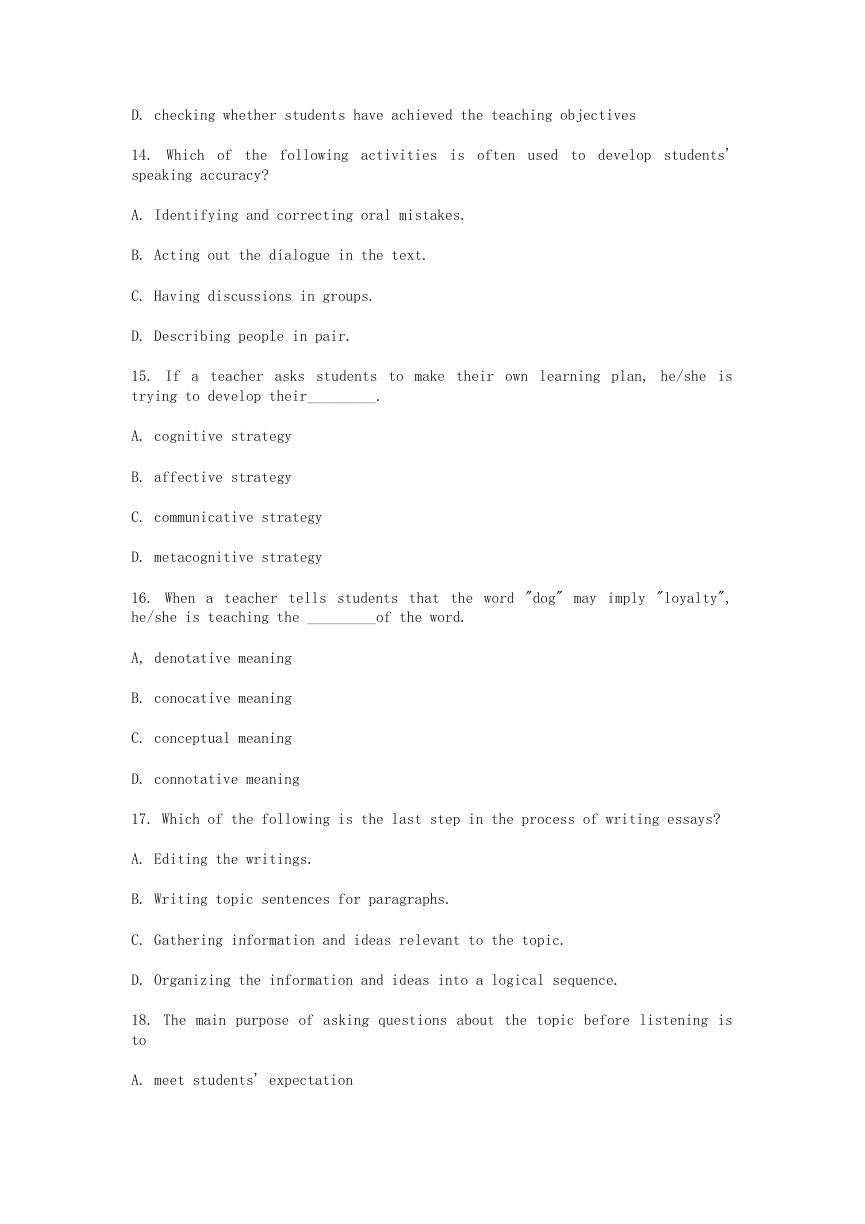
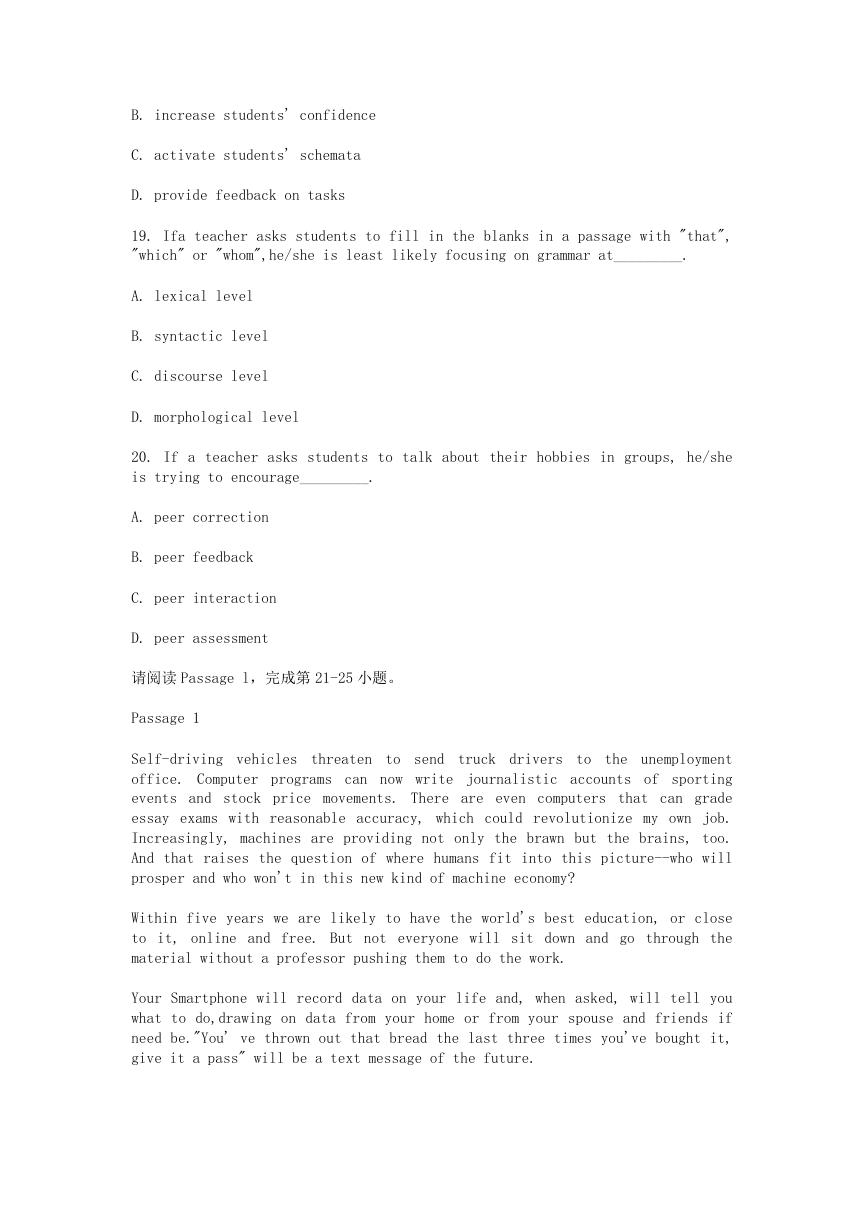
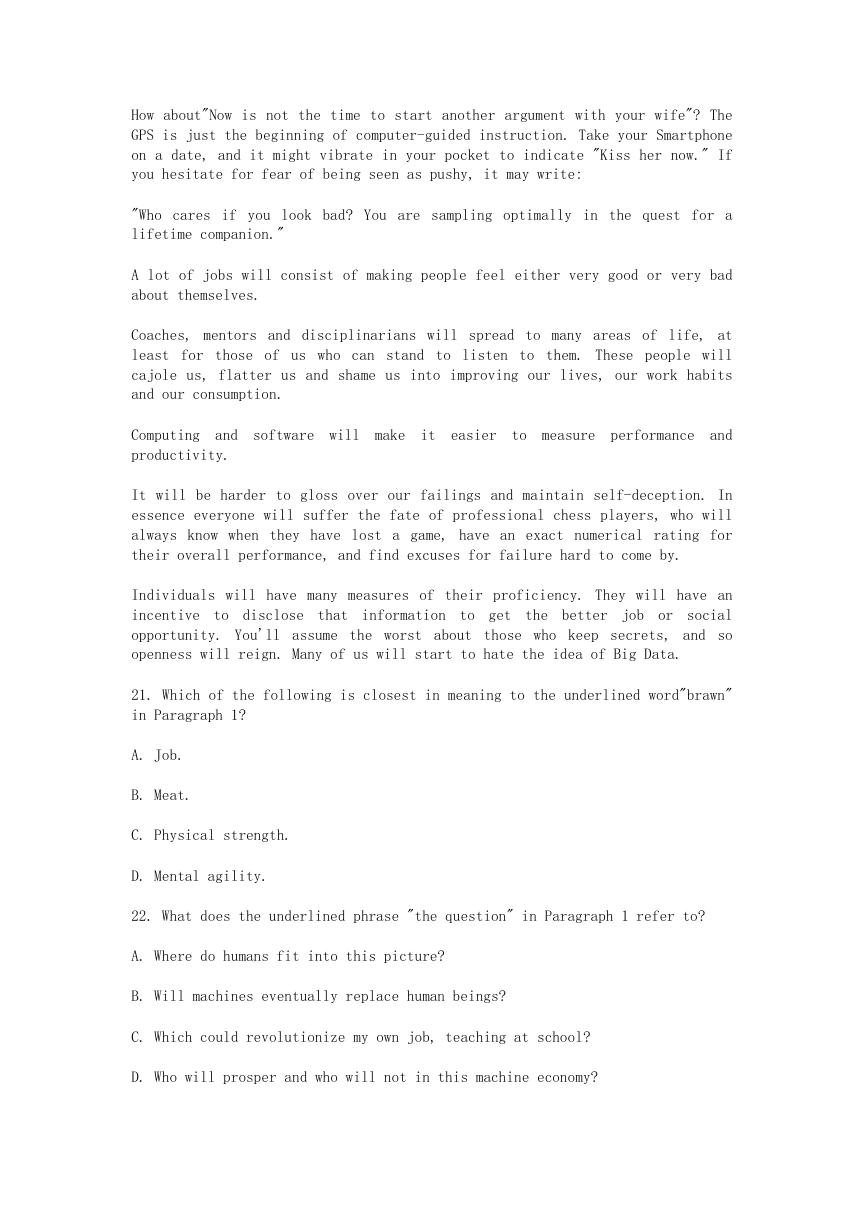
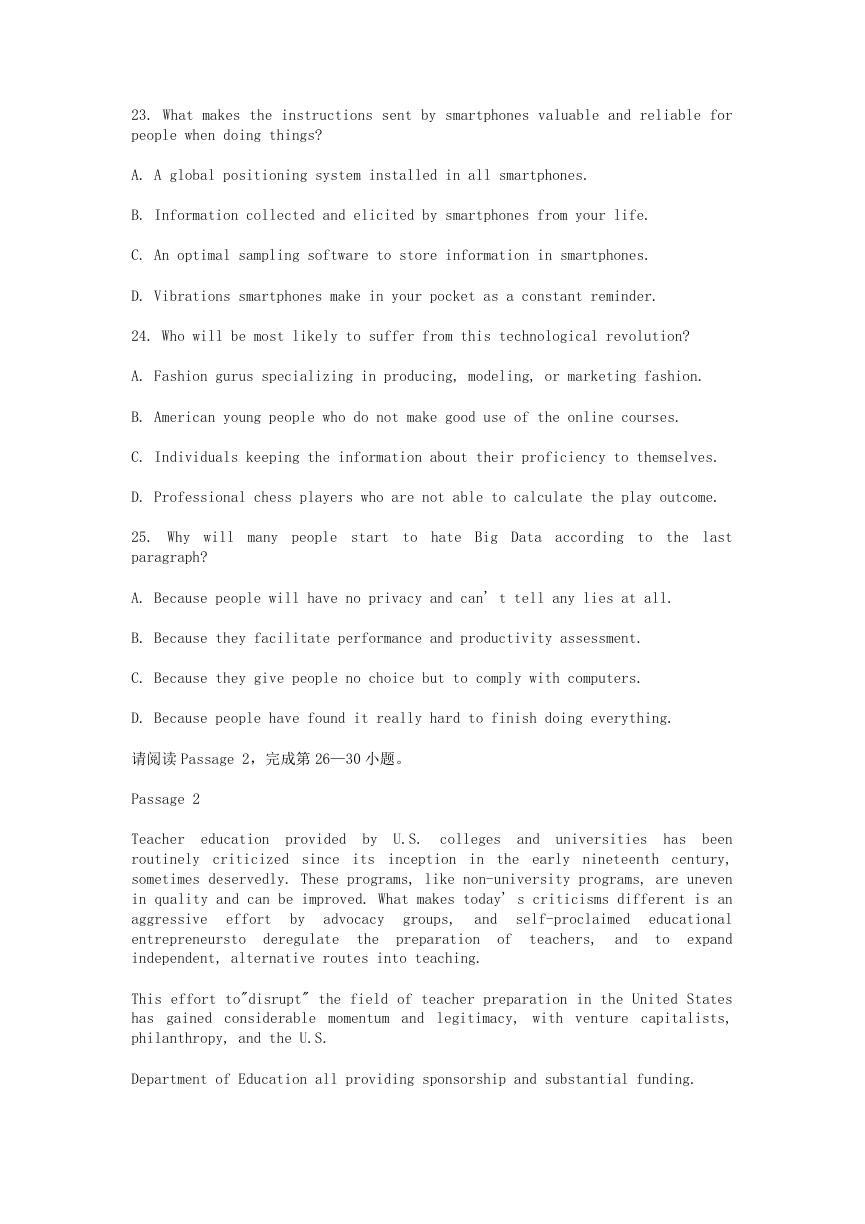
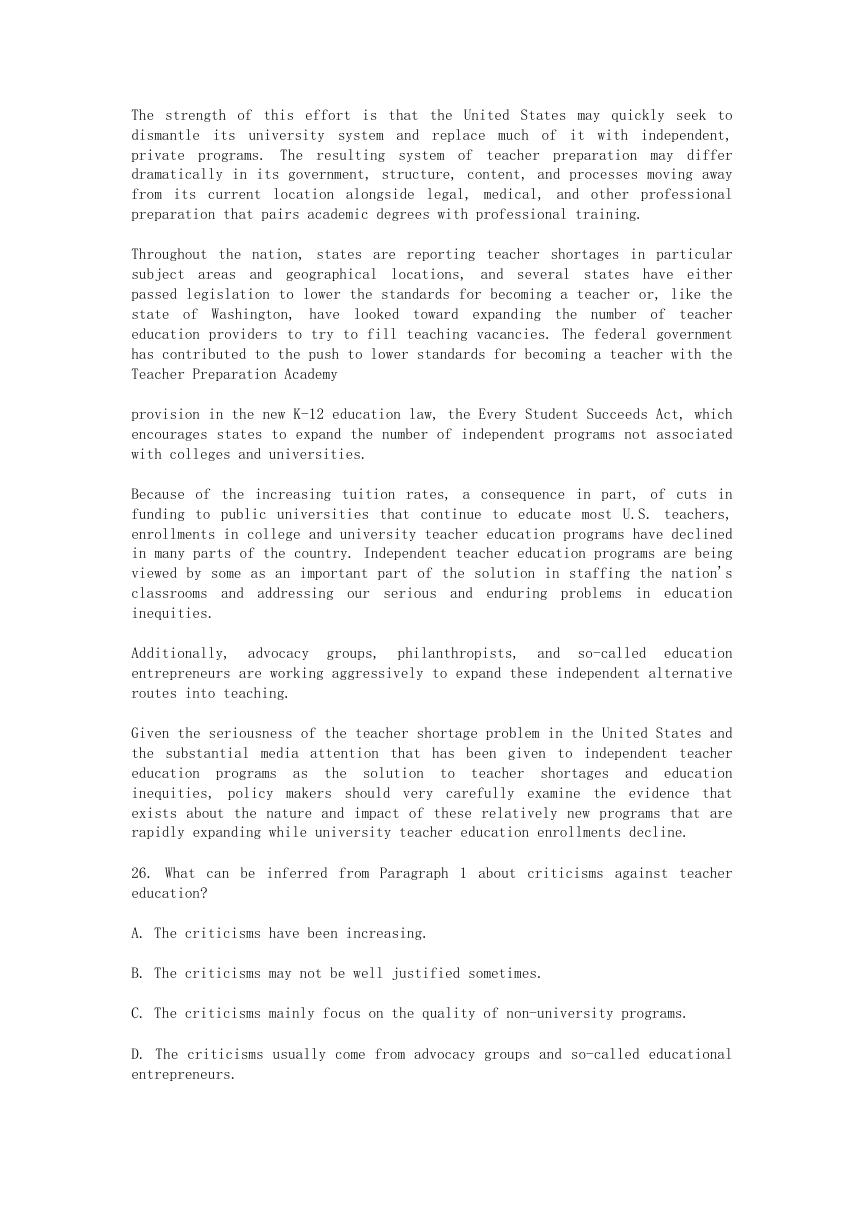








 2023年江西萍乡中考道德与法治真题及答案.doc
2023年江西萍乡中考道德与法治真题及答案.doc 2012年重庆南川中考生物真题及答案.doc
2012年重庆南川中考生物真题及答案.doc 2013年江西师范大学地理学综合及文艺理论基础考研真题.doc
2013年江西师范大学地理学综合及文艺理论基础考研真题.doc 2020年四川甘孜小升初语文真题及答案I卷.doc
2020年四川甘孜小升初语文真题及答案I卷.doc 2020年注册岩土工程师专业基础考试真题及答案.doc
2020年注册岩土工程师专业基础考试真题及答案.doc 2023-2024学年福建省厦门市九年级上学期数学月考试题及答案.doc
2023-2024学年福建省厦门市九年级上学期数学月考试题及答案.doc 2021-2022学年辽宁省沈阳市大东区九年级上学期语文期末试题及答案.doc
2021-2022学年辽宁省沈阳市大东区九年级上学期语文期末试题及答案.doc 2022-2023学年北京东城区初三第一学期物理期末试卷及答案.doc
2022-2023学年北京东城区初三第一学期物理期末试卷及答案.doc 2018上半年江西教师资格初中地理学科知识与教学能力真题及答案.doc
2018上半年江西教师资格初中地理学科知识与教学能力真题及答案.doc 2012年河北国家公务员申论考试真题及答案-省级.doc
2012年河北国家公务员申论考试真题及答案-省级.doc 2020-2021学年江苏省扬州市江都区邵樊片九年级上学期数学第一次质量检测试题及答案.doc
2020-2021学年江苏省扬州市江都区邵樊片九年级上学期数学第一次质量检测试题及答案.doc 2022下半年黑龙江教师资格证中学综合素质真题及答案.doc
2022下半年黑龙江教师资格证中学综合素质真题及答案.doc